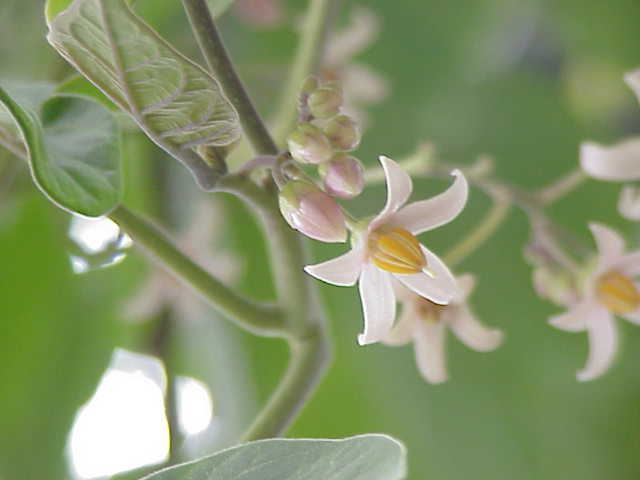|
Cyphomandra
''Cyphomandra'' was a formerly accepted genus in the plant family Solanaceae (the nightshades and relative). It used to contain about 35 species native to the Americas from Mexico southwards to Northern Argentina. Recent authors have treated ''Cyphomandra'' as a clade within the genus ''Solanum'' rather than as a separate genus, uniting the members of the old genus with some other ''Solanum''. This lineage is one among a group related to part of the traditional subgenus ''Leptostemonum''. Thus, if it is preferred to retain the taxon, ''Cyphomandra'' is probably best considered a section in ''Solanum'' subgenus ''Leptostemonum''. Most grow as shrubs or small trees 2 or 3 metres in height. The best known species is the widely cultivated Tamarillo or tree tomato, but a number of the others are also cultivated as garden plants because of their attractive flowers or fruits. Several other species (e.g. '' S. cajanumense, S. circinatum, S. sibundoyense'') also have fruits that ar ... [...More Info...] [...Related Items...] OR: [Wikipedia] [Google] [Baidu] |
Solanum Sibundoyense
''Solanum sibundoyense'' is a species of plant in the family Solanaceae. It is endemic to Colombia, specifically to Sibundoy and surrounding areas, and usually resides in cloud forests, 1400–2300 meters in elevation. It is also known as tomate salvaje or tomate silvestre to natives of Colombia, and also sometimes called ''Cyphomandra sibundoyensis''. It's a small tree 4–8 m tall. Stems glabrous or sparsely puberulent with glandular and eglandular hairs less than 0.5 mm long. Uses The fruits are edible and have a pleasant acidulous taste.Bohs, L. 1994. Cyphomandra (Solanaceae). Flora Neotropica Monograph 63, New York Botanical Garden, page 134. The plant produces some of the largest fruits known in section Pachyphylla. The fruit pulp of some trees is sweet, juicy, and pleasant-tasting, and in others it is acidulous, and without any sweetness. A purplish layer of soft pulp surrounds the seeds. Fruits ripen slowly, but once ripe their shelf life is longer than that of ... [...More Info...] [...Related Items...] OR: [Wikipedia] [Google] [Baidu] |
Tamarillo
The tamarillo (''Solanum betaceum'') is a small tree or shrub in the flowering plant family Solanaceae (the nightshade family). It is best known as the species that bears the tamarillo, an egg-shaped edible fruit. It is also known as the tree tomato, tomate de árbol, tomate andino, tomate serrano, blood fruit, tomate de yuca, tomate de españa, sachatomate, berenjena, chilto and tamamoro in South America, and terong Belanda (Dutch eggplant) in Indonesia. It is popular globally, especially in Peru, Colombia, New Zealand, Ecuador, Rwanda, Burundi, Australia, Bhutan and the United States. Description Plant origin and regions of cultivation The tamarillo is native to the Andes of Ecuador, Colombia, Peru, Chile, Argentina and Bolivia. Today it is still cultivated in gardens and small orchards for local production, and it is one of the most popular fruits in these regions. Other regions of cultivation are the subtropical areas throughout the world, such as Burundi, Kenya, ... [...More Info...] [...Related Items...] OR: [Wikipedia] [Google] [Baidu] |
Solanum Circinatum
''Solanum'' is a large and diverse genus of flowering plants, which include three food crops of high economic importance: the potato, the tomato and the eggplant (aubergine, brinjal). It is the largest genus in the nightshade family Solanaceae, comprising around 1,500 species. It also contains the so-called horse nettles (unrelated to the genus of true nettles, ''Urtica''), as well as numerous plants cultivated for their ornamental flowers and fruit. ''Solanum'' species show a wide range of growth habits, such as annuals and perennials, vines, subshrubs, shrubs, and small trees. Many formerly independent genera like ''Lycopersicon'' (the tomatoes) and ''Cyphomandra'' are now included in ''Solanum'' as subgenera or sections. Thus, the genus today contains roughly 1,500–2,000 species. Name The generic name was first used by Pliny the Elder (AD 23–79) for a plant also known as , most likely ''S. nigrum''. Its derivation is uncertain, possibly stemming from the Latin word , m ... [...More Info...] [...Related Items...] OR: [Wikipedia] [Google] [Baidu] |
Solanum Diploconos
''Solanum'' is a large and diverse genus Genus ( plural genera ) is a taxonomic rank used in the biological classification of living and fossil organisms as well as viruses. In the hierarchy of biological classification, genus comes above species and below family. In binomial n ... of flowering plants, which include three food crops of high economic importance: the potato, the tomato and the eggplant (aubergine, brinjal). It is the largest genus in the nightshade family Solanaceae, comprising around 1,500 species. It also contains the so-called horse nettles (unrelated to the genus of true nettles, ''Urtica''), as well as numerous plants cultivated for their ornamental flowers and fruit. ''Solanum'' species show a wide range of growth habits, such as annual plant, annuals and perennial plant, perennials, vines, subshrubs, shrubs, and small trees. Many formerly independent genera like ''Lycopersicon'' (the tomatoes) and ''Cyphomandra'' are now included in ''Solanum'' ... [...More Info...] [...Related Items...] OR: [Wikipedia] [Google] [Baidu] |


